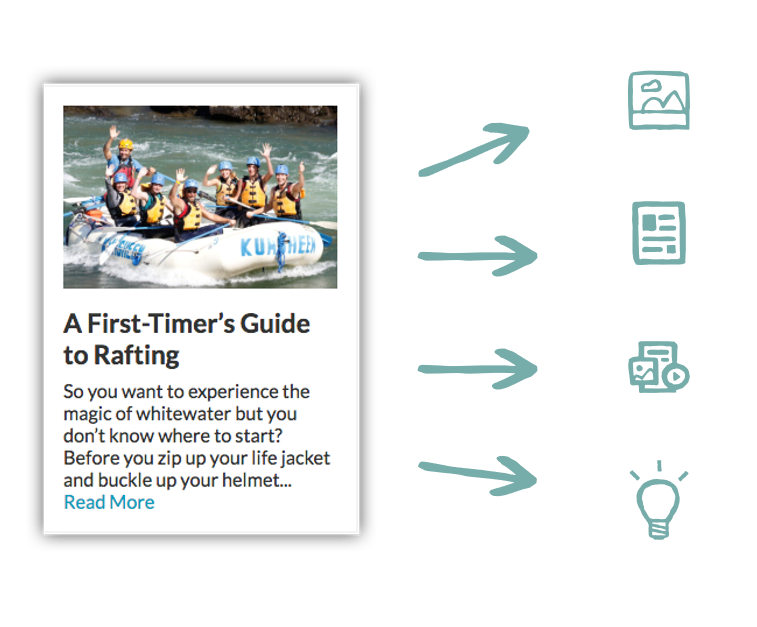
3 Reasons Your Business Needs a Content Calendar
From blog posts and email newsletters, to Instagram stories and tweets, there are more ways than ever to attract, connect and engage with your ideal customers. But with so many platforms and channels to consider and manage, it’s tricky to keep track of all the moving parts.
If your business has a small team—or maybe even just a single person managing all of your marketing—a content plan helps make the most of your limited time and resources while enabling you to meet the demands of always-on content marketing.
Here are three reasons to start using a content calendar today:
1. Consistency is key
Studies tell us it takes between six and twenty touch points with a business before a consumer considers making a purchase with them. In a world filled with constant promotions and competing information, it’s important to stay top of mind with your audience by providing them with consistent, quality content.
Creating a publishing cadence (or frequency) that works for your audience enables you to create stronger, long-term relationships with them, so when they’re ready to book or purchase next, they’ll think of you first.
Bonus! Documenting your plan in a calendar also helps you and your team to stay accountable.
2. Reduce, Reuse, Repurpose!
Your content calendar allows you to plan how to maximize the life and impact of each new piece of content you create. In fact, it’s likely that content you already have can be repurposed and expanded on. For example, if your business has a popular blog post, video, or image gallery, think about all the places you can share (and re-share) that content. Can the content be tweaked or modified for a different platform or digital channel? Can some of the content be expanded on or updated?
For example: Imagine you’ve set aside some time to capture photos of a new offering, like a seasonal product or experience that your business will be launching soon. You plan on adding these images to your website. Then what?
- You have enough photos that you could create a series of story slides for Instagram or Facebook, showing off the new features in short form. Stories are a great format for quick updates and behind-the-scenes information to let your followers know what is happening now. With the right copy, stories can serve as the kick-off for announcing a new product and help you develop a lead-up to the big event.
- Use some of the best shots to post to your Instagram grid, or Facebook profile to reflect the latest offerings. Provide more details and information on how to book the experience with a link in the caption (for Facebook) or by driving people to your link in bio (for Instagram). Remember: Social media profiles are often amongst the top search results for brand names.
- Use the photos and the captions you wrote for Facebook and Instagram and expand them into a longer blog post. Use comments or feedback you’ve received from previous guests or followers and add short testimonials to enrich your storytelling.
- Share the blog post as a link post to Facebook and Twitter, and add it on your linktr.ee for Instagram.
- If you have an email marketing list, use the blog post as part of your next newsletter or promotion, along with information on how to book and make the most of the experience.
- Rinse and repeat! By envisioning your content as a series of extensions from a key anchor piece, you can slot in more content into your calendar by considering a variety of channels and formats side by side.
The best part? Based on the insights you glean when measuring how each of your posts performs, you can reshare the best ones again next year or test out new ideas to see what works.

This is an example of an activity guide that Kumsheen River Rafting created. Just imagine all of the content opportunities available!
3. It’s never too early to start planning
Reduce your stress and last-minute panic by doing as much of the heavy lifting as possible during quieter times of the year. Gather and review your assets well in advance of holidays and peak seasons to determine what needs to be created, captured, and ultimately published and shared. For example, if you plan to make an announcement for summer and anticipate a busy season, capture or create your content assets in the fall or spring when your team has more time available.
Slow periods are a great time to preplan social media captions or blog content for example, even if you don’t intend to publish the content for a while yet. Slower periods are also a good time to review your metrics and do some research on what’s resonating with your audience and identify any content gaps or themes to plan content around.
Here are a few places to explore:
Website and social media analytics
Review the engagements happening on your website and social media posts (views, likes, comments and shares) as well as the overall reach. Review the content themes for top pages or posts each month to see what content has the most positive reactions from your audience.
Google Trends
Use Google Trends and the Keyword Planning Tool to dive into search queries related to your business to help you get into the mindset of your customers and spark ideas for future content. The search volume (and competitiveness with Google Ads) can help you to narrow in on topics that would make for great content.
Search Insights
Leverage the data from billions of searches people have already performed on Google to source ideas for content will resonate with your target market. For more tips on how to use insights to generate content ideas, see Using Search Insights to Spark New Content Ideas.
Thinking bigger? How about a collaboration!
Working together with another business can help to leverage both of your audiences for even better results. These often require a bit more planning in advance, and your content calendar will be sure to help keep everyone on track.
There are thousands of templates, programs, apps, and platforms out there (e.g. Hootsuite, HubSpot, Sprout Social, Airtable, Google Sheets, etc.) – including the template Destination BC’s team has developed for small businesses. Find one that works for your business and customize it to suit your needs.
A little preparation in the beginning goes a long way and often means the difference between just creating content and creating content that meets your marketing objectives and your customer’s needs.





